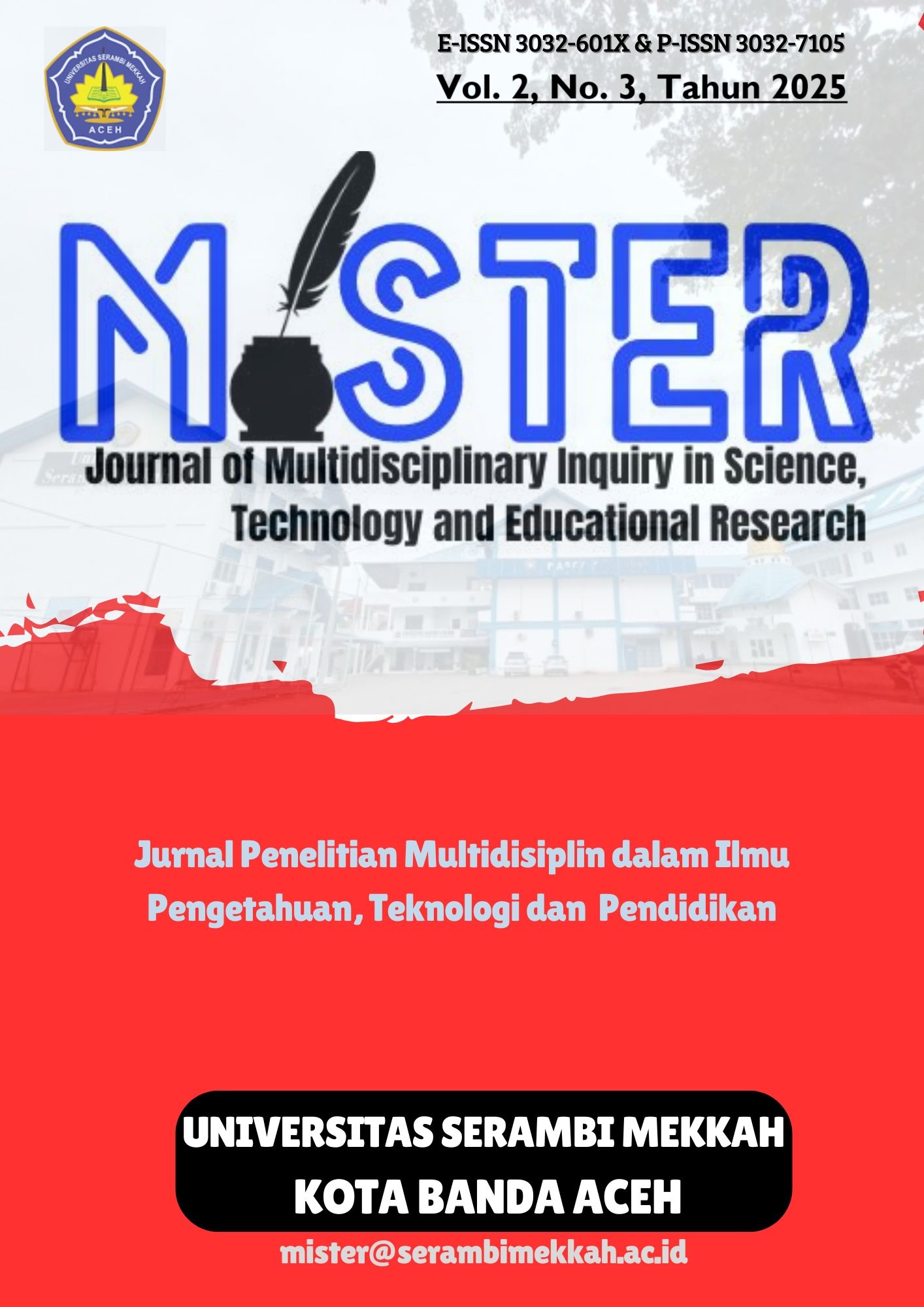Analisis Kuantitatif Kadar Tembaga (Cu) dalam Sampel Air Menggunakan Spektrofotometri UV-Vis
Main Article Content
Abstract
The presence of copper metal (Cu²⁺) in water needs to be analyzed because its concentration can affect the quality and safety of water, especially for consumption. This study aims to determine the levels of Cu²⁺ in various water samples using the UV-Vis spectrophotometry method with ammonia (NH₃) complexing. Copper ions form a blue complex [Cu(NH₃)₄]²⁺ which is analyzed at a maximum wavelength of 615 nm. The calibration curve was obtained from a standard solution with the linear equation y = 0.0016x + 0.0003, which was used to calculate the concentration of Cu in water samples. The results of the analysis showed that the concentration of Cu in gallon water, bottled water, PDAM water, and well water I was still below the maximum limit of 2.0 mg/L set by the Indonesian Minister of Health Regulation No. 2 of 2023, while well water II had a Cu content of 6.688 ppm, exceeding the safe limit. Sources of Cu ions in water can come from weathering of rocks containing copper minerals or anthropogenic activities such as industrial waste. Excessive Cu content in the body has the potential to cause health problems. Therefore, water with high Cu levels requires further treatment, such as adsorption, ion exchange, or phytoremediation, before being used for consumption purposes.
Article Details

This work is licensed under a Creative Commons Attribution-ShareAlike 4.0 International License.
References
Ab Hamid, N. H., bin Mohd Tahir, M. I. H., Chowdhury, A., Nordin, A. H., Alshaikh, A. A., Suid, M. A., Nazaruddin, N. ‘Izzah, Nozaizeli, N. D., Sharma, S., & Rushdan, A. I. (2022). The Current State-Of-Art of Copper Removal from Wastewater: A Review. Water (Switzerland), 14(19), 1–15. https://doi.org/10.3390/w14193086
Aini, S., Alfian, Z., & Agusnar, H. (2022). Analysis of the Copper (Cu), Chromium (Cr), and Manganese (Mn) Levels from the Steel Industry Liquid Waste by Atomic Absorption Spectrophotometry Method. Journal of Chemical Natural Resources, 4(1), 72–76. https://doi.org/10.32734/jcnar.v4i1.10502
Altunay, N. (2018). Development of vortex-assisted ionic liquid-dispersive microextraction methodology for vanillin monitoring in food products using ultraviolet-visible spectrophotometry. LWT-Food Science and Technology, 93, 9–15. https://doi.org/10.1016/j.lwt.2018.03.021
Amri, M. A. (2021). Pengaruh Air Permukaan terhadap Air Tanah berdasarkan Data Muka Air Tanah Dangkal Daerah Danau Sunter dan Sekitarnya. PETRO:Jurnal Ilmiah Teknik Perminyakan, 10(3), 176–179. https://doi.org/10.25105/petro.v10i3.10828
Dewi, L., Hadisoebroto, G., & Anwar, K. (2021). Penentuan Kadar Logam Timbal (Pb) Dan Tembaga (Cu) Pada Sumber Air Di Kawasan Gunung Salak Kabupaten Sukabumi Dengan Metode Spektrofotometri Serapan Atom (SSA). Jurnal Sabdariffarma, 9(2), 15–24. https://doi.org/10.53675/jsfar.v3i2.393
Espada, J. J., Rodríguez, R., Delgado, A., Vicente, G., & Bautista, L. F. (2024). Assessing Environmental Sustainability of Phytoremediation to Remove Copper from Contaminated Soils. Sustainability (Switzerland) , 16(6). https://doi.org/10.3390/su16062441
Guspita, D., & Ulianas, A. (2020). Optimization of complex NH3 with Cu2+ ions to determine levels of ammonia by UV-Vis spectrophotometer. Journal of Physics: Conference Series, 1481(1). https://doi.org/10.1088/1742-6596/1481/1/012040
Husak, V. (2015). Copper and Copper-Containing Pesticides: Metabolism, Toxicity and Oxidative Stress. Journal of Vasyl Stefanyk Precarpathian National University, 2(1), 38–50. https://doi.org/10.15330/jpnu.2.1.38-50
Iversen, P. O., & Fogelholm, M. (2023). Fluid and water balance: a scoping review for the Nordic Nutrition Recommendations 2023. Food and Nutrition Research, 67(1), 1–5. https://doi.org/10.29219/fnr.v67.9975
Kartal, L. (2025). Selective Removal of Copper from Nickel – Copper Leach Solution by Electrolysis Cells with High Convection. Metals, 15(432), 1–15.
Krason, J., & Pietrzak, R. (2018). Removal of Iron and Copper Ions from the Liquid Phase by Modified Polymeric Membranes. Journal of Polymers and the Environment, 26(8), 3237–3242. https://doi.org/10.1007/s10924-018-1201-z
Liang, Q., Jiang, L., Zheng, J., & Duan, N. (2024). Determination of High Concentration Copper Ions Based on Ultraviolet—Visible Spectroscopy Combined with Partial Least Squares Regression Analysis. Processes, 12(7). https://doi.org/10.3390/pr12071408
Mallik, A. K., Kabir, S. F., Bin Abdur Rahman, F., Sakib, M. N., Efty, S. S., & Rahman, M. M. (2022). Cu(II) removal from wastewater using chitosan-based adsorbents: A review. Journal of Environmental Chemical Engineering, 10(4), 108048. https://doi.org/10.1016/j.jece.2022.108048
Mörschbächer, A. P., Dullius, A., Dullius, C. H., Bandt, C. R., Kuhn, D., Brietzke, D. T., Malmann Kuffel, F. J., Etgeton, H. P., Altmayer, T., Gonçalves, T. E., Oreste, E. Q., Ribeiro, A. S., de Souza, C. F. V., & Hoehne, L. (2018). Validation of an analytical method for the quantitative determination of selenium in bacterial biomass by ultraviolet–visible spectrophotometry. Food Chemistry, 255(September 2017), 182–186. https://doi.org/10.1016/j.foodchem.2018.02.057
Nassef, E., & El-Taweel, Y. (2015). Removal of Copper From Wastewater By Cementation From Simulated Leach Liquors. Journal of Chemical Engineering & Process Technology, 06(01), 1–6. https://doi.org/10.4172/2157-7048.1000214
Palanivel, T. M., Pracejus, B., & Novo, L. A. B. (2023). Bioremediation of copper using indigenous fungi Aspergillus species isolated from an abandoned copper mine soil. Chemosphere, 314(October 2022), 137688. https://doi.org/10.1016/j.chemosphere.2022.137688
Pratiwi, N. A., & Sunarto. (2018). Perbandingan Validasi Metode Analisis Ion Tembaga(II) tanpa Pengompleks dan dengan Pengompleks Na-Dietilditiokarbamat secara Spektrofotometri UV-Vis. II, 96–105.
Ridho, R. (2021). Aplikasi Fotokatalis Tio2-Resin Pada Fotoreduksi Ion Cu2+. Jurnal Crystal : Publikasi Penelitian Kimia Dan Terapannya, 3(1), 1–11. https://doi.org/10.36526/jc.v3i1.1424
Sliwa, E. I., ´Sliwi ´nska-Hill, U., Ba˙zanów, B., Siczek, M., Klak, J., & Smolenski, P. (2016). Synthesis, Structural, and Cytotoxic Properties of NewWater-Soluble Copper(II) Complexes Based on 2,9-Dimethyl-1,10-Phenanthroline and Their One Derivative Containing 1,3,5-Triaza-7- Phosphaadamantane-7-Oxide. Molecules, 25(741), 1–20.
Wuana, R. A., & Okieimen, F. E. (2011). Heavy Metals in Contaminated Soils: A Review of Sources, Chemistry, Risks and Best Available Strategies for Remediation. ISRN Ecology, 1–20. https://doi.org/10.5402/2011/402647
Zhang, Y., Zhao, H., Zhang, Y., Qian, L., Zhang, L., Meng, X., Lv, X., Abhilash, Janjua, H. A., & Qiu, G. (2019). Interactions Between Marmatite And Bornite During The Oxidative Dissolution Process In Abiotic And Biotic Systems. RSC Advances, 9(46), 26609–26618. https://doi.org/10.1039/c9ra03658j
